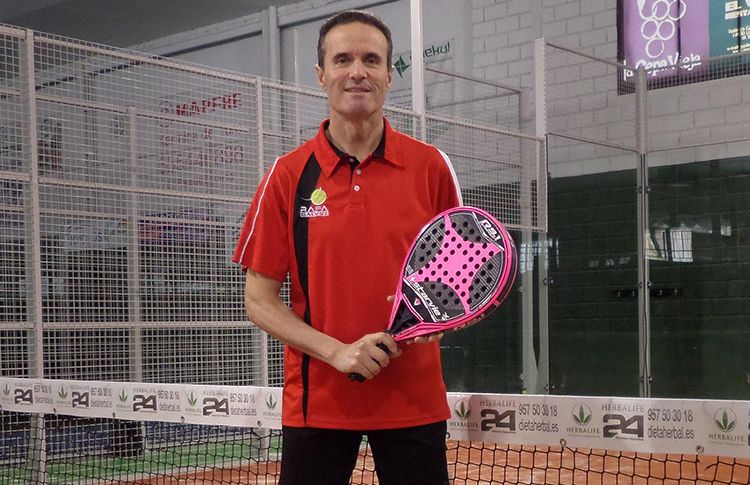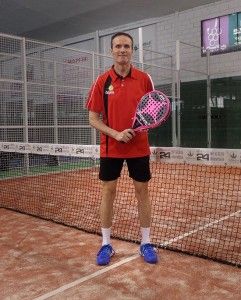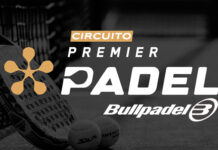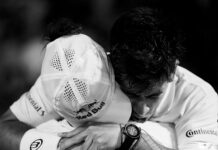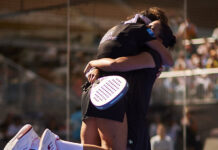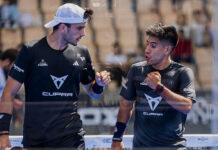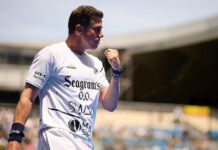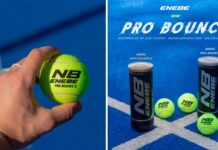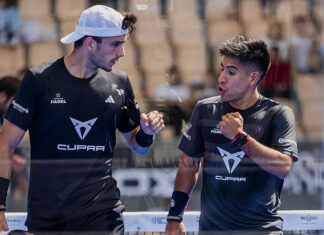Our colleague Daniel Gamarra has interviewed the creator of one of the relevant channels in the world of paddle tennis. His videos of technical, tactical and physical training analysis have served, and still serve, to help many fans of this sport who do not have the means to hire a physical trainer but still want to continue improving their sport.
Padel World Press .- It is very likely that he did not even imagine it when he started this adventure but more and more fans of the world of paddle are waiting for his new videos, some of which have gone beyond the 22.000 visits.
Our colleague Daniel Gamarra was able to speak with this Cordovan, whom he defined as "a great professional who only wants to transmit some of the knowledge that he has to all the fans of this sport, so that they can improve as much as possible without this entailing a great economic expense ".
Currently, Rafa is a monitor in a paddle club in the city of Lucena (Córdoba), so his professional life is based on teaching and taking some time to stay in shape, moments when he takes advantage of his recordings videos to later upload them to your channel, with the hope that someone can help you.
What did you study and what titles related to sports activity do you have?
All my stages as a student were developed entirely in Lucena, where I finished the Superior Bachelor. Then I opted to enter the world of work and parked the university studies. Working already was when I had the opportunity to dedicate myself fully and professionally to the world of tennis education and I was trained for that task, obtaining the title of Monitor and National Referee for the RFET. In more recent dates, and seeing that a sport called padel, that many people did not know, was beginning to take a lot of prominence and had a great potential for expansion, I got the title of National Teacher for the RPP to leave the door open for me. There was also the opportunity to teach padel classes. From there, you can see what happened with the paddle. A vertiginous growth that has led to a lot of demand for classes, which means that now it is totally focused on it.
How many years have you been teaching paddle tennis?
I consider myself privileged because I have managed to make my hobby my profession and 26 are already in it. The last 4 I have dedicated exclusively to the teaching of paddle and, during the previous two, I shared the time with tennis lessons.
Are you still competing or are you fully dedicated to being a coach?
Well almost fully to the classes. Although I am very focused and dedicated to teaching, with the dedication time it entails, I have to tell you that I have not completely abandoned the competition and I do participate in the tournaments I can ... Especially in the Andalusian Veterans Circuit of the FAP.
What methods, techniques do you use in your paddle lessons? Do you use videos or material from your channel?
The saying goes that 'each teacher has his book' and, in my case, that book was written during the 24 years of teaching that I was in tennis. I support myself a lot in this in my padel classes. But I am of the opinion that we should not stay there. Like any professional who boasts of being one, you have to keep training because everything evolves and there are always new things that can be useful to improve your classes and in the achievement of the objectives set. You do not have to cling completely to a teaching style or a method. I prefer to be flexible like a bamboo rod and not rigid like a log. After all, what is involved is that the student has fun, learn, exercise and, for this, the more knowledge you have, the better ... It will benefit the student.
Yes I can say that I am very demanding with the technique, which I consider essential if you want to progress. From there, I am of the opinion that you have to put the student in real game situation as soon as possible, either through exercises that reflect the different situations of the same or playing directly, being the perfect excuse to introduce them in the tactics and in the knowledge of the rules by which the paddle is governed. And that's where my video channel comes into play as a didactic tool, where I show students how professional players face these different situations of play, in which decisions must be made in very short time units. Next, we try to apply it but, as is obvious, always adjusted to its level.
I also support myself in photographs of players where I perform technical and tactical analyzes that surely you will have seen in my Facebook, and that I also refer to the students (like the videos) so that they can have them as a reference manual. Let's say that I do not limit the class to what can be worked on the track and experience has shown me that the student feels a greater degree of attention towards their training, which means that they become more involved, feel more motivated and eager. to improve.
Video-analysis is another good tool that I use. Nothing better for a student than to see himself performing this or that blow. And in a tablet we analyze what happens in detail. New technologies offer a very good opportunity to make a difference and facilitate student training. We have to take advantage of it.
What do you like most about your profession?
As I said before, I think that working on what you like is a real privilege ... As I am, and I hope to continue being for many years, a lover of my profession, in my case leaves few options to 'what you like the least'. The personal satisfaction of seeing how people learn and progress weighs a lot. It is a valuable prize and a constant reinforcement that feeds my desire to continue in the world of teaching.
Are you in charge of a professional player? Would you like it?
No, I do not have any professional player to train or carry. My experience in this sense is null and for now, I have not raised it. But as a personal experience with which I can enrich my training more, I would like to be somewhat closer to that world of professionalism.
What is your favorite WPT Circuit player?
Difficult question I think ... Since I like several: the auction of one, the volley of another, the tray of that, etc, hehehe. But I would stay with Sanyo Gutiérrez and Fernando Belasteguín in boys and with Eli Amatriain and Carolina Navarro in girls. Paquito Navarro, Matías Díaz and Ramiro Moyano I also have them on the list, hahaha. They are the ones I most identify with when I see them play. Bela for how complete, solid, consistent and great defender he is, and for how well he manages to always choose the option that can be more profitable for the interests of the couple. Something very difficult to put into practice. Let's say you don't usually raffle a ball, you don't get anything for free. Sanyo, for me, is anticipation, improvisation, fantasy, magic ... A delight to see him in action and perform this sport. In fact, they are the two players who appear the most on my video channel. You can learn a lot from them. From Carolina and Eli I love the way they perform on the court, the quality of their actions and blows, their fighting ability and, above all, the consistency they are capable of showing even in the most extreme and adverse situations.
When did the idea of the channel arise?
The channel was created by the 29 of August of 2011 but the upload of the first video was back in January of 2013 ... It was a gift of Three Wise Men that I made because it was in particular the 8 day when I published my first video, of tennis at that time , since I was still with the classes. Since then 199 videos are already the ones I have hosted in the channel, mainly paddle.
How would you define your channel? What is your function? Who is it for?
I consider it as a video reference manual where the player, regardless of their level of play, can find information on the very different aspects of paddle tennis, especially from a tactical point of view, although there is also technical and physical preparation content. With the important presence that new technologies have in our lives today, together with the boom experienced by social networks, they made me decide that I had to take advantage of it in some way because it was a good excuse to be able to be more in contact with my students and more committed if possible with their training.
With the creation of the channel I wanted to give them a plus, something new and not only the limited content of a weekly class of 60 or 90 minutes. So I got down to work and investigated what was on the net about content topics of padel videos. Although there were many, I observed that there was a certain vacuum in particular in relation to tactical analysis of games or plays, that is, what professionals do in their matches, why successes and failures occur, why they throw to one place or another , why are they placed in this or that place on the track, etc ... So I got into it and started uploading videos in which I analyzed points drawn from matches of professional players and players, all analyzed from the point of view tactical. And is that when we see a point of these all followed, without any pause, it is more difficult to appreciate those details that are important and, ultimately, end up causing the mistake of the rival, or the success, or how the point has been built , etc ... I thought it was a good content to do something different, so I decided to start preparing videos in order to make it easier for me to give a higher level of quality to the training of my students. Also, by logical empathy, I decided to share them on social networks so that they could reach as many more people as possible. And well, the acceptance has been quite good.
How many subscribers do you currently have?
Well, they are almost 2000, specifically 1939 subscribers and almost 850.000 visualizations.
Do you get any kind of economic benefit for your channel?
Not at all. That was not the purpose for which I considered creating the channel. As I said before, I simply wanted to have a new and different didactic tool to be able to share padel contents with my students in order to improve their training and that this would not be limited only to the duration of the class on the track.
How many people a month write asking questions about physical preparation, technical aspects or nutrition?
Some yes that there are but they are not relevant figures. Of course, all I attend as soon as possible and with the utmost professionalism and enthusiasm.
What is a normal day like for Rafa Gálvez?
Well, I get up early, about the 08: 00, and without much delay, then we have to make the first energy charge for the body, the most important of the day. Then I sit down and review the content scheduled for the classes of the day, in case something needs to be touched up. I attend e-mails, consultations, etc., review social networks and, finally, I review the list of contents that I have prepared on different aspects of paddle in case it is appropriate to prepare something to send to my students and share on social networks (making pictures , montage of videos, etc ...). On alternate days I make room to dedicate time to my physical preparation, I consider it very necessary because you have to perform and be at the top both to endure many hours on the track and to play and compete.
Lunch on the 13: 30-14: 00 hours, rest and for the club since at 17: 00 hours starts rolling the ball. Although in the morning there are usually classes, in my case it is in the afternoon when I have the largest block. We closed the day on the 23: 00-23: 30. Back home dinner, recovery, stretching (this is never missing) and very important for me, reflection on what happened during the work day.
Finally, I briefly review social networks and, to relax a bit, I take the opportunity to read something, especially articles related to paddle tennis, physical preparation, nutrition and sports medicine. Training always accompanies me. And as the body is already OFF, then to rest.
What message would you like to send to the fans?
Yes, I would like to thank my brother-in-law, Jesús Berjillos, because he was the first to pinch me so that he could follow the padel in order to be able to teach, as it ended up happening. To my work colleague and friend Gustavo Machuca, I thank him for all he has taught me and contributed from his extensive experience in the world of paddle, both on and off the slopes.
And finally, to my great friend, the 'captain' Chema Santos, who one day, precisely through the paddle, I was lucky to cross my path. With him I have also learned many things of paddle but above all beyond the paddle.
I finish I would like to ask a favor to those who are taking paddle lessons or to those who are going to enroll in some school to receive them. For the sake of dignifying our profession of monitors, now that paddle is so fashionable, I would like you to simply demand PROFESSIONALISM, that a monitor or coach is not professional in the teaching of paddle by the simple fact of putting a car next to balls and ready, to throw balls. Behind that word there is much more. Not everything is worth it.
A big thank you to Padel World Press for looking at me for and giving me this opportunity so that you can all get to know me a little more.
Greetings and keep enjoying this sport.
* You can follow all the news of the world of paddle in our profiles of Facebook y Twitter as well as subscribe to our Newsletter .

